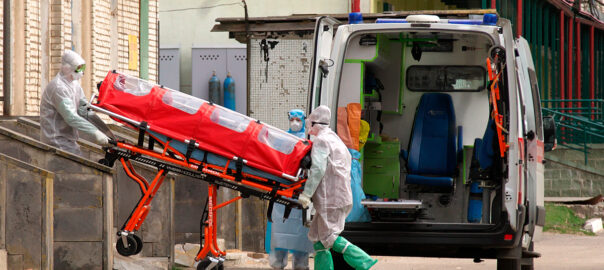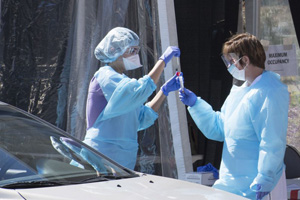
What’s Next?
We know for certain we will have another pandemic; but we don’t know when or where it will begin.
After three years of post-COVID reflections, papers, books and documentaries, we are finally seeing governmental and global policies that acknowledge the most important lessons learned: we must be better prepared to act immediately, to move rapidly, to share information across disciplines, and to communicate to the public honestly and effectively. And we must practice how we will do that. But the big question remaining is whether we have the political will to address these recommendations, given all the competing interests here and abroad as well as other demands on financial resources.
The COVID pandemic was not a once-in-a-lifetime episode. Consider these events:
- Three influenza pandemics (1957, 1968, 2009).
- The HIV pandemic.
- A re-emergence and global spread of Zika & Mpox (with an increase in cases in 2023).
- A tripling in the frequency of infectious disease outbreaks between 1980 and 2010.
- Finally, after years of following the spread of avian flu around the world between wild and domestic birds, we have recently seen avian flu jump from cattle to humans, though we have yet to see human-to-human infection in the US. The concern with H5N1, or avian flu infections, from the global experience is that it carries a mortality rate of 56%.
Preparing for the Next Pandemic
Since mid-2023 we have begun to move a fragmented system toward corrective measures for pandemic preparedness. In 2023 the US Government Accountability Office (GAO) wrote that it has “made about 400 recommendations to improve the government’s response for future public health emergencies. Congress and agencies have taken actions on about 45% of these recommendations.”
Several developments will guide the next steps toward pandemic preparedness and response:
- First, in July 2023, the Biden White House announced the formation of an Office of Pandemic Preparedness and Response led by physician and Major General Paul Friedrichs.
This new office is charged with leading, coordinating, and implementing actions related to preparedness and the response to known and unknown biological threats or pathogens that could lead to a pandemic or to significant public health-related disruptions in the United States. These activities include enhancing the US supply chains for PPE and pharmaceuticals and convening the various partners for dialogue and planning. Having such an office in the White House is also important to raise awareness of and support for the US pandemic preparedness plan, although it is extremely vulnerable to political change.
- The second development is the Global Health Security Strategy, also announced from the White House in April 2024. This effort will focus on US international preparation surveillance assistance and response and will be led by Dr. Stephanie Psaki.
[Both of these new offices may not be supported in the new Trump administration.]
- The third initiative is from the World Health Organization and is currently being negotiated. In December 2021, the World Health Assembly established the Intergovernmental Negotiating Body to draft and negotiate a WHO international instrument for pandemic prevention, preparedness and response. That body has recently extended their work until May 2025. The major sticking point besides funding has been the assurance of equity in access to testing, therapeutics and vaccines, given the slow rollout of vaccines and therapeutics in the less developed world during COVID.
- One of the most forward-thinking initiatives is the 100 Days Mission. In June 2021, the countries representing the G7 and G20, and the WHO, together organized this effort to create an optimal state of readiness for the production of diagnostics, therapeutics and vaccines (DTVs) that would enable the most efficient and equitable response possible to emerging pandemic threats. The International Pandemic Preparedness Secretariat (IPPS) was charged with implementing the 100 Days Mission. This timeframe was chosen symbolically since 1.6 million people died in the first 100 days because there were no treatments or vaccines for the prevention of COVID.
The IPPS started by identifying 10 viruses that have potential to become the next pandemic: SARS-CoV-2 (COVID-19), Middle East Respiratory Syndrome (MERS), SARS-CoV-1 (SARS), Ebola, Marburg, Crimean-Congo Hemorrhagic Fever (CCHF), Rift Valley Fever (RVF), Lassa fever, Nipah virus and Zika virus. For each group of identified viruses, the goal is to identify viable vaccines, rapid diagnostic tests and an initial regimen of therapeutics.
It was hoped this initiative would reach its goals and be complete by 2026. But so far, few tests, treatments or vaccines have been approved for any of the viruses except COVID and Ebola. Vaccine research and development have seen progress, but diagnostics and therapeutics are underfunded and lagging. An example of the challenges facing this initiative is that the projected cost of developing one therapeutic drug for an infectious disease—like Paxlovid, for example—is 1.2 billion dollars!
As memories diminish and other priorities vie for attention, it will take enormous effort and strong leadership to keep a forward momentum.
- As of June 2024, the Healthcare Workforce Resilience Act (HWRA) is making its way through the Congressional process to address the health care workforce shortages that were exacerbated in the pandemic response. Much of the emphasis here is in providing a sufficient number of immigration visas for nurses, physicians and their families.
Health and Human Services has also begun several initiatives to support rural health care, a traditionally underserved segment of the population. These actions have already produced a series of improvements, including a record number of patients being served in rural and underserved communities through Health Resources and Services Administration-supported health centers; increased scholarships and loan repayment assistance awards through the National Health Service Corps for physicians and nurses currently providing care in rural and underserved communities; a major expansion of training and teleconsultation access for primary care providers to treat mental health conditions and integrate mental health into school-based health centers; new grants supporting training for new primary care doctors to better serve individuals with limited English proficiency and individuals with disabilities; the release by the CMS Center for Medicare and Medicaid Innovation of a new payment and care delivery model, Making Care Primary, which aims to advance health equity and test the provision of enhanced payments, resources, and data to primary care clinicians; the expansion of disciplines whose services are paid by Medicare to further support multidisciplinary teams; the distribution of new primary care residency slots to underserved areas; and actions that facilitate behavioral health and primary care integration. For example, the Substance Abuse and Mental Health Services Administration’s Strategic Plan for 2023–2026 includes advancing the integration of behavioral and physical health care as one of five key priority areas. Also, HHS is in the early stages of developing a Primary Care Dashboard that will monitor the “health” of our nation’s primary care system and the impacts of HHS actions to strengthen primary care.
External Stories and Videos

Has our dishonesty prolonged the pandemic and increased the spread of this deadly disease?
UPI
At the height of the COVID-19 pandemic, more than 40% of Americans were untruthful about whether they had the virus or were ignoring safety precautions.

Watch: Coronavirus Is Our Future
Alanna Shaikh, TEDx
Global health expert Alanna Shaikh talks about the current status of the 2019 nCov coronavirus outbreak and what this can teach us about the epidemics yet to come.

Watch: How We must Respond to the Coronavirus Pandemic
Bill Gates, Chris Anderson & Whitney Pennington Rogers, TED
Bill Gates offers insights into the COVID-19 pandemic, discussing why testing and self-isolation are essential, which medical advancements show promise and what it will take for the world to endure this crisis.
